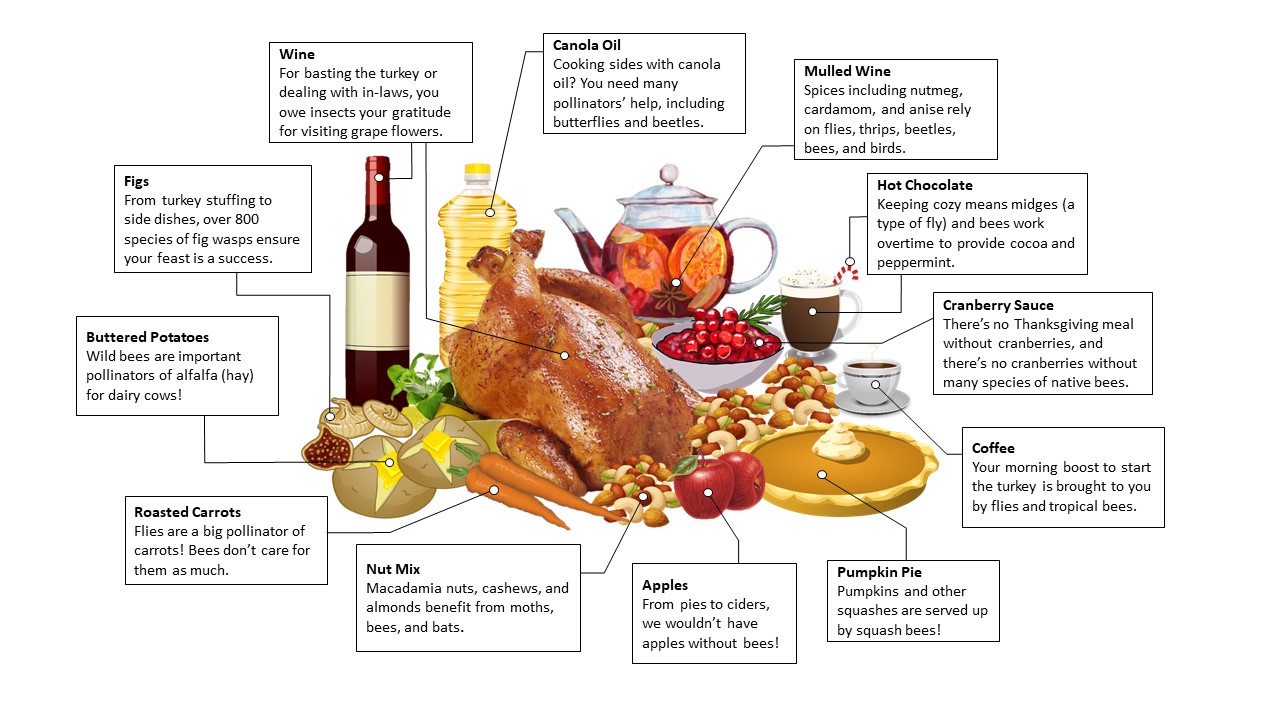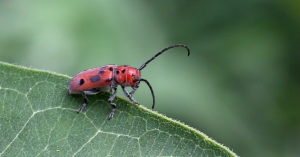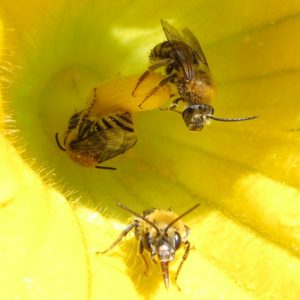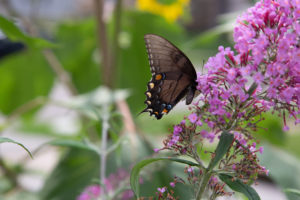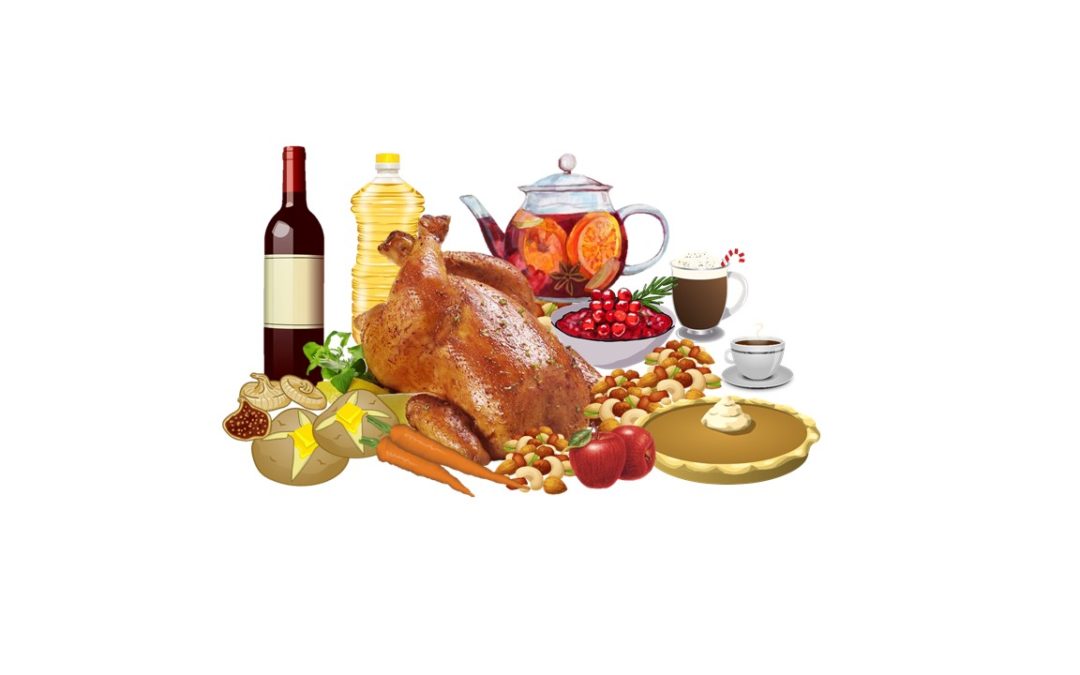
by Jessica Butters | Oct 29, 2022
We’re dipping into the season of gratitude. Although it’s definitely cliché, I feel like many of us who sniffed at the idea of owning a gratitude journal have inevitably found ourselves thankful for small, everyday things more often than we did a few years ago. The truth is, the sum of many small things makes a big difference, and this rings true for the natural world as well.
The graphic above depicts some typical Thanksgiving Day food that either depends upon or may benefit from animal pollination, as well as pest control from wasps, birds, and bats. It is not an exhaustive list!
Who runs the world? Bugs!
E. O. Wilson said it best: insects are the “little things that run the world”, and that includes pollinators. Pollinators are not only key to the survival of about 87% of Earth’s flowering plant species; they are also a major food source for many animals, and around 35% of our world’s food crops depend upon them. The food we cook for a Thanksgiving meal, and many of our other meals, comes from all over the world. It is consequently imperative to appreciate and protect the biodiversity of the entire planet.
We rely on squash bees in our gardens to pollinate our pumpkins, and tropical flies and beetles to pollinate coffee and spice plants such as nutmeg, anise, and cardamom. If you hunt for a wild turkey this fall, know that about 10% of its diet was comprised of insects (and it required even more when it was a poult). And while not all of our food or cultivars require animal pollination, we clearly need all kinds of insects to run the world, from South American flies we will probably never notice or see, to the monarchs that bless our backyard gardens in summer.
A Value of Their Own
Pollinators, and all wildlife for that matter, have intrinsic value, and should not be valued purely based on the goods and services they provide for humans. Pollinators and other wildlife have played key roles in nature and agriculture long before we realized it, and will continue to do so after we forget about them (but let’s try not to forget). The purpose of this article is to bring to light just how dependent we really are on all “the little things”. Whether we choose to value pollinators, insects, and nature in general or not, we are sustained by the air, plants, and diverse food groups they support. So at your next Thanksgiving meal, give a mulled wine toast to the little things!
Sources for percentages:
- Ollerton J, Winfree R, and Tarrant S (2011) How many flowering plants are pollinated by animals?
Klein A.-M., Vaissière B. E., Cane J. H., Steffan-Dewenter I., Cunningham S. A., Kremen C., & Tscharntke, T (2007) Importance of pollinators in changing landscapes for world crops.
- Brigida D, Mizejewski D (2021) NWF Blog: 6 Tips for Feeding Wild Turkeys with Your Garden.
Pollinators/beneficial insects listed in the Thanksgiving food graphic were informed in part by the Pollinator Partnership.
by Janice Gammon | Jan 29, 2016
The Corridor Management Plan is coming along nicely. From our community input meetings, reviewing city comprehensive plans, and discussions with officials in communities and counties along the Byway we certainly have an exhaustive amount of information and ideas to make a very detailed living document.
I have kept my nose to the grindstone for a while now and did come up for air last week when I took a few days off. The second day back, I attended the Travel Federation of Iowa’s Legislative Showcase at the State Fairgrounds. This was the first event I attended last year when I began as the coordinator of the Lincoln Highway Heritage Byway. I know SO much more about the Lincoln Highway and Byways in general than I did last year at this time. I was able to talk about the Lincoln Highway and the Iowa Byway program to the legislators as they passed by the Iowa Byways’ booth and encouraged them to continue their support of tourism.
This event is also a great way to network with chambers and attractions along the Byway. I chatted with Alan from the Boone and Scenic Valley Railroad, Mark from Council Bluffs Convention and Visitors Center, Taylor from the Cedar Rapids Area Convention and Visitors Bureau and many others. I also had a chance to talk with my fellow Byway coordinators about projects, successes, and challenges.
An upcoming event will be hosted by the Iowa Byways. The Heartland Byway Conference will be April 4th-6th in Council Bluffs and we are very excited to have attendees learn more about Western Iowa including the Loess Hills Scenic Byway, Western Skies Scenic Byway, and the Lincoln Highway Heritage Scenic Byway. These three Byways intersect and conjoin for a bit at the Harrison County Historical Village and Welcome Center in Missouri Valley, just north of Council Bluffs. One afternoon, we will take a tour of the Loess Hills and this will be one of the stops.
Key note speakers at the conference will be Michelle Matt, Chuck Offenburger, and the Path Less Peddled. Breakout sessions will include topics such as working with volunteers, GIS, interpretive plans, marketing, infrastructure, corridor management planning, team work, and creating an authentic experience. Anyone interested in Byways and tourism or involved with chambers, visitor bureaus, or serves on an advisory board or volunteers at an attraction is welcome to attend.
I am so excited to be a part of this event! Besides increasing my knowledge and networking with fellow professionals, there will be great food and that bus trip through the Loess Hills! I am looking forward to spending time on this side of the Lincoln Highway Heritage Byway and experience the Loess Hills, Hitchcock Nature Center, and the communities along the route. I am also excited to reconnect with the other Lincoln Highway Byway coordinators from Indiana, Ohio, and Nebraska. We met at the National Scenic Byway training last summer in Ohio and made plans to meet again in Council Bluffs!
If you want to attend, please register at www.brownpapertickets.com. The conference will be held at the Holiday Inn & Suites, 2202 River Road in Council Bluffs. I will tell you all about it in future posts. Be sure to check our Facebook page for photos!
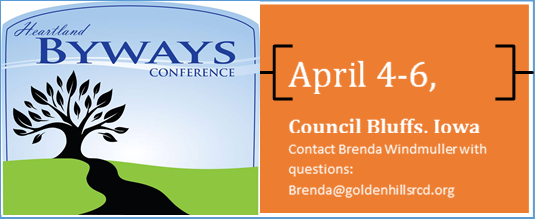
by Janice Gammon | Aug 17, 2015
Summer has been a busy time along the Byway! I did make it to the Mahanay Bell Tower Festival in Jefferson and rode the elevator 120 feet up to the observation deck of the 14-story Tower. What a view!! It gave me a whole new perspective of the countryside and it was great to see the Lincoln Highway as a ribbon running through it. I also enjoyed the beautiful Thomas Jefferson Gardens and RVP~1875, where they make furniture with only hand tools. Its like stepping back in time and they’ll even show you what they are working on!
Another great tour is the Sawmill Museum in Clinton in the Lyons District on the north side of the city. Lyons was the name of the town where the first bridge linked Illinois to Iowa on the Lincoln Highway. Lyons is now part of Clinton. The Sawmill Museum has great displays of the history of the lumber industry in Clinton. It was a “must see” for me and I recommend it for all ages.
The annual Lincoln Highway Association conference was held in Ann Arbor, MI this year. Participants could tour downtown Detroit, the Packard proving grounds, and the archives at the Bentley and Hatcher Libraries at the University of Michigan. Detroit is not on the Lincoln Highway, but has deep connections to the auto industry and to the men who organized the Lincoln Highway and its route.
Another event, although held in Ankeny, did bring a focus to the the Lincoln Highway Heritage Byway when the Harley Owners Group (H.O.G.) Rally had, among many rides, a featured ride to Marshalltown and then to Ames via the Byway. Prairie Rivers of Iowa set up a booth at the H.O.G. Rally and gave out information about the Lincoln Highway Heritage Byway and the Byway program in Iowa. Motorcyclists are very interested in the 2-lane scenic views as their ride (journey) itself is often more important than the destination.
The most recent event I attended was the 101st Meskwaki PowWow held just outside of Tama. I enjoyed the music and dancing, native items for sale, and food vendors. I especially liked the Indian fry bread. Next time I’ll try it as an Indian Taco. Although they invited the spectators to come join in the last dance, I did not. I’ll do that next time as well! Pacing myself.
I am able to travel the state along the Byway and learn more about the communities and their history, strengths, challenges, and plans for the future. We continued the Corridor Management Plan community input meetings,having now held 15 of them across the state. By meeting many of the community leaders and members in each town, we have been able to gather insight into what the Lincoln Highway has done for their community and what it can do for them in the future.
Many communities and counties are working on future ideas as well such as the Story County Cornerstone to Capstone (C2C) project and the plans for the Nevada downtown streetscape. The Boone Historical Museums are partnering with the University of Iowa in developing their 4 museums. I have been working with residents and government officials concerning bridges in the city of Tama and in Linn County. A new Grant Wood mural has been painted on the side of a building in eastern Iowa. The overpass outside of Grand Junction will be replaced in the next few years. There are so many more projects and Ideas in different phases along the Lincoln Highway. It will be exciting to see them all come to fruition!
We are working on a baseline measurement of the economic impact of the Byway. If you are traveling the Lincoln Highway, please stop in one of these locations and fill out a survey about your trip: Sawmill Museum in Clinton, the Belle Plain Museum in Belle Plaine, Lincoln Cafe and Wine Bar in Mt Vernon, John Ernest Vineyard and Winery outside Tama, King Tower restaurant in Tama, Niland Cafe in Colo, Greene County Museum in Grand Junction, Mahanay Bell Tower in Jefferson, Cronk’s restaurant in Denison, the Harrison County Historical Village and Iowa Welcome Center in Missouri Valley, and the Union Pacific Railroad Museum in Council Bluffs.
There will also be a survey for residents to fill out and we should be rolling that out this fall, so stay tuned.
In the meantime, let’s get traveling the Lincoln Highway Heritage Byway!
by Janice Gammon | May 5, 2015
The past two weeks have been a whirlwind of getting to know the Byway. John Mazzello, the Corridor Management Plan project coordinator, and I have been traveling the across the state holding public meetings. The input from individuals and professionals has been stellar! It has been fun getting to know the communities and see what they have to offer to residents and Byway travelers.
Where do I start with the scenery I have seen? The first day of traveling, everything looked all brown and yucky from winter’s cold. Then a good rain happened in the night and the next day it seemed all the buds on trees and bushes had sprung to life. The grass started greening too. For so many past springs, I have worked in an office and not really been able to witness the “Spring has Sprung” phenomenon!
I have seen many wetland restoration projects along the Byway. I especially like the one to the west of Tama near the Otter Creek Marsh and in the Iowa River Corridor Bird Conservation Area. This area is rich in Meskwaki Nation history and their love of this land. It has an interpretive site detailing the Meskwaki story. A mounted binocular allows you to see the birds and wildlife that inhabit the area up close without disturbing them.
Nearby in Toledo is a cow and calf sculpture high on a hillside that honors Norma “Duffy” Lyon, the lady who for years sculpted the Butter Cow at the Iowa State Fair. (Although Toledo is NOT on the Byway- it’s close enough and I just have loved the Butter Cow at the Iowa Sate Fair for years!)
The trip to Clinton was fun because we traveled across a bridge to Illinois and came back across it to see what people’s first impressions would be of Iowa. I liked that Clinton incorporated the “L” in the Lincoln Highway logo with the “L” in their town name. It is such a great river town and has a long lumber industry history. Many historic mansions are still intact from its heyday when Clinton had the most millionaires per capita due to the lumber industry.
In Western Iowa, we learned that Jesse James was rumored to have hid out in the hills recuperating after a shootout. Carroll County has a history of bootlegging operations tied to Al Capone. And Abraham Lincoln once owned land in Iowa. There are so many more stories that came to light during these meetings. I can’t wait for us to compile them and share them in a more formal way!
And every trip needs to include food. We ate at Sister’s Country Kitchen in Logan. My chef salad at lunch was so huge, that I had the rest for supper! I also had a sandwich at the Lincoln Cafe in Belle Plaine that was very tasty. Wished I’d taken a picture of it, but I guess that means I’ll have to go back!
This is just a sampling of our experiences and I can’t wait to add to them. Tourist season and festivals are right around the corner! Let’s go explore the Lincoln Highway Heritage Byway!
by Janice Gammon | Mar 31, 2015
The Lincoln Highway Byway is just a part of the Iowa Byway program (www.iowabyways.org). There are eleven in total. Two are National Byways and nine are state Byways. The two National ones are the Loess Hills (along the Missouri River) and the Great River Road (along the Mississippi River). The Lincoln Highway Heritage Byway connects with the two National Byways at Clinton (on the Mississippi River side) and in Missouri Valley to Council Bluffs (on the Missouri River side).
Two other byways connect to the Lincoln Highway Heritage Byway. The Iowa Scenic Valley shares LeGrand, Montour, Tama, Chelsea, and Belle Plaine with the Lincoln. Our road heads back north to Marion and Cedar Rapids and theirs heads south to Marengo and the Amanas.
Western Skies Scenic Byway also connects with the Lincoln in Missouri Valley and they both head north to Logan and Woodbine. The Lincoln keeps going north to Dunlap, but the Western Skies heads east to Harlan , Kimballton, a side trip to Elk Horn, then to Guthrie Center, Panora and south to Stuart.
The other byways are Historic Hills Scenic Byway in southeast Iowa, Glacial Trail Scenic Byway in northwest Iowa, Driftless Area Scenic Byway and River Bluffs Scenic Byway in northeast Iowa, and Delaware Crossing Scenic Byway and Grant Wood Scenic Byway in east central Iowa.
That makes eleven! Did you notice something about the names of the other byways? Yes, they all contain the word scenic. The Lincoln Highway is the only Heritage (historical) Byway. Our main importance is the road itself.
Now that’s not to say there isn’t anything scenic along the Lincoln Highway (there is!). But the Lincoln Highway was created as the first transcontinental road from TImes Square to San Francisco, thus making it a very historic road. Originally the road was marked with red/white/blue signs and a large “L” in the middle. The Department of Transportation has used that same design and added the Iowa Byway logo for the modern signage. Just hop on the route anywhere and follow the signs. Some places you might be on pavement and in other places you might be on gravel for a bit. (Like between Ames and Boone.)
I am learning about the Byway and all there is to do and see. We are currently conducting public meetings in communities along the byway and will create a new corridor management plan. It is really fascinating to meet and work with the people in these communities.
So far, some of my favorite places to see are the Des Moines River Valley between Boone and Ogden, the footprints left in the 1929 pavement in Ogden, the Meskwaki settlement near Tama, the Lincoln Bridge on E 5th St in Tama that has the words “Lincoln Highway” in the concrete side panels, the Reed/Niland Cafe in Colo, and old gas stations in Jefferson.
Travelers need to eat. Recently, I have eaten at the Reed/Niland cafe and explored the interpretive panels inside the cafe, eaten Iowa’s best tenderloin at the Lucky Pig in Ogden, had a King Club at King Tower in Tama, and tried the Lincoln Highway red wine at the Santa Maria Vineyard and Winery in Carroll . The newest edition of Edible Iowa has an article about food along the Lincoln Highway. I am sure I will be taste testing more along the Byway in the coming months.
Iowa’s festivals and fairs will begin in the next few months. Just to name a few I hope to attend are Tama’s Lincoln Bridge Festival, the Bell Tower Festival in Jefferson, and the Meskwaki Pow Wow near Tama. Let’s go explore and celebrate along the Lincoln Highway!


